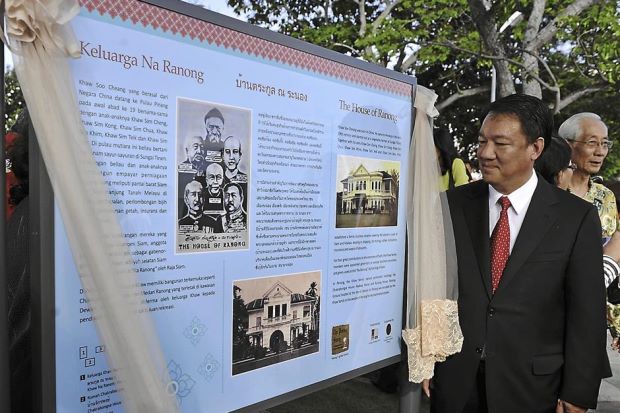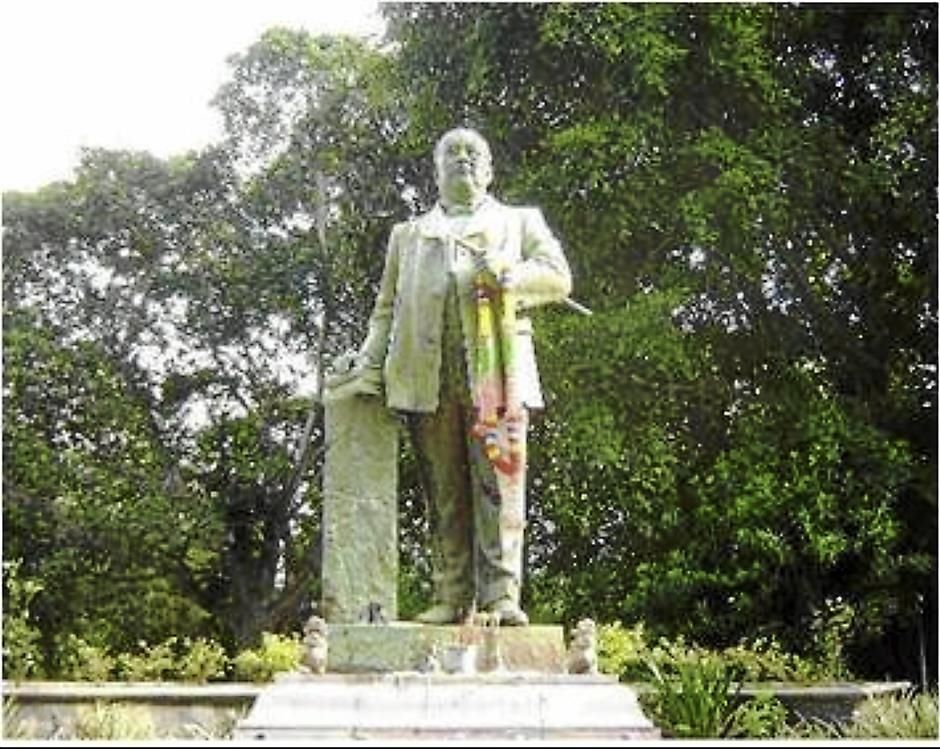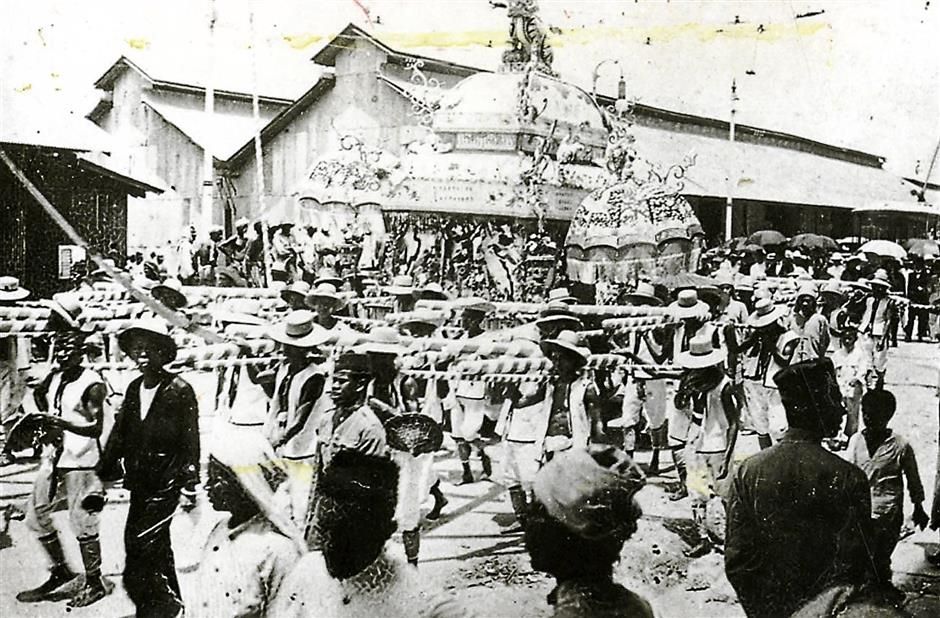
Well-connected: Kittiratt Na-Ranong launching the House of Ranong signboard at the Esplanade in May. The deputy prime minister and finance minister for Thailand is a direct descendant of Sim Bee’s older brother, Sim Kong.
THE distance between Penang and Hatyai, the southern Thai city, is just 183km, and it only takes about three hours to get there if you drive. Weekend getaways for shopping and other things are very much a part of life for many Penangites.
And if one wishes to head to Phuket, it would just be another two hours or so. That’s how close Penang is to these two southern Thailand towns.
Captain Francis Light, who founded Penang in 1786, had established his headquarters in Salang, near Phuket, about 10 years earlier. It was also in Phuket that he met his Eurasian wife, Martha Rozells.
As early as 1771, he had tried to convince his superiors to take up the Sultan of Kedah’s offer of Penang in return for British protection, but his letter was largely ignored.
Finally in 1786, he got the attention of Sir John MacPherson, the Governor-General, and was able to convince him on the need to secure a British trading post in Penang.
Today, many Penangites have relatives in these two Thai towns with the northern Hokkein dialect, spoken in Penang and Kedah, widely used there.
For many years, the Chinese community in southern Thailand would send their children to study at the Han Chiang High School in Penang so they could pick up Chinese and English.
Today, due to that foresight, the top editors of The Nation, the top English-language newspaper of Thailand, all come from southern Thailand.
One Thai-Chinese businessman who made an impact in Penang was Khaw Sim Bee. A road, which runs from Perak Road to Westlands Road, is named after him.
Khaw was born to a wealthy family in 1857. His father, Khaw Soo Cheang, was the Governor of Ranong, Southern Thailand.
Through these strong connections, Khaw began serving the Siamese government as a royal page and went on to become the Governor of Trang, a southern Thailand province in 1890.
He introduced rubber plantations into the region, which according to many accounts, helped in “increasing the productivity of the impoverished south, winning him favour with the king.”
In May this year, some 300 descendants of Khaw Sim Bee gathered in Penang to commemorate the 100th death anniversary of the man remembered as the ‘Father of Thailand’s Rubber Industry’.
Khaw was influential in south Thailand but it was in Penang that he found his true love when he married a Chinese woman, Lim Seng Kim, and the couple had five sons. But there was more to Khaw’s love life than this, as future events would unveil.
The family left behind two beautiful mansions in Penang, the Asdang House (the current site of Mayfair condominium) and Chakrabongse House in Jalan Sultan Ahmad Shah. Unfortunately, the houses were demolished in 1993 and in the 1970s respectively.
The family also donated the Ranong Ground (where the Dewan Sri Pinang now stands) in Jalan Padang Kota Lama in the late 19th century to the people of Penang for recreational purposes.
The family’s historian Teik Gim, who is a sixth-generation Khaw, gave a presentation on the family’s background during a conference titled “Penang Story Symposium: Khaw Sim Bee na Ranong and Shared History of Malaysia-Thailand Relations: From The Past To Future Cooperation” during the gathering.
He said the family patriach, Khaw Soo Cheang, arrived in Penang in 1810 from Fujian, China, before going to Thailand in 1822, which was a remarkable achievement for an immigrant as he went on to become a governor of Ranong!
He had six sons — Sim Cheng, Sim Kong, Sim Chua, Sim Khim, Sim Teik and Sim Bee.
The Star also quoted Teik Gim as saying that Sim Kong and Sim Bee were the high commissioners of Monthon (country subdivision) Chumphon and Monthon Phuket respectively.
Meanwhile, Sim Khim and Sim Teik were the governors of Kraburi and Langsuan, respectively, carrying the title “Phrayas” while Sim Cheng and Sim Chua were assistant governors of Ranong with the title “Luangs”.
Teik Gim further elaborated on Sim Bee’s achievements, which included being appointed the Governor of Trang in 1890 and sub-sequently the High Commissioner of Monthon Phuket in 1900.
The power link of the Khaws in Thailand seems to have continued even today.
The conference was also attended by Thailand Deputy Minister and Finance Minister Kittiratt Na Ranong, who is a direct descendant of Sim Bee’s older brother, Sim Kong. Kittiratt’s Chinese name is Khaw Cheng Thong.
The 55-year-old Kittiratt is today Deputy Prime Minister and Finance Minister in the Cabinet of Prime Minister Yingluck Shinawatra.
Despite the glorious past of Khaw Sin Bee’s legacy, there is a blot with reports describing him as “a polygamous man and a notorious womaniser.”
This proved to be his undoing, according to a report, as he was killed by a doctor in Trang whose wife he had his eyes on.
The shooting took place on Feb 25, 1913. Also wounded was his nephew, the Governor of Trang.
Khaw Sim Bee and his nephew were rushed to the Penang hospital, but succumbed to their injuries on April 10 and May 2, respectively, the reports said.
But Khaw Sim Bee continued to be held in high regard, particularly by the people of south Thailand, from Ranong to Phuket to Trang.
A statue erected in his honour can be seen at the Khao Rang hill in Phuket.
For this writer, there is a Thai link, too. My brother, Wong Chun Keong, has a lovely Thai wife, Naiyana, whom he met when she came to Penang from Hatyai to study at Han Chiang.
My wife, Florence, still has Thai relatives in southern Thailand from her grandmother’s side.
At Universiti Kebangsaan Malaysia, it was compulsory for all students to sign up for a foreign language and I signed up for Thai, although it was not quite my first choice.
I had initially set my sights on studying French, Spanish or Korean, regarding them as languages with more economic value. But after a long night, I turned up late for registration and classes for all the more popular languages were fully booked.
As fate would have it, I happily signed up for Thai, enjoying the formal Thai classes. Along the years, I have lost the conversational skills despite my many trips to Thailand each year.
For many Penangites and Kedahans, especially those with family ties that bind, Thailand continues to be just a short distance away by road or by air.







